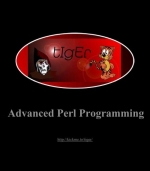Advanced Perl Programming by Sriram Srinivasan

Категория: Other
Поделиться:
This book has two goals: to make you a Perl expert, and, at a broader level, to supplement your current arsenal of techniques and tools for crafting applications. It covers advanced features of the Perl language, teaches you how the perl interpreter works, and presents areas of modern computing technology such as networking, user interfaces, persistence, and code generation. You will not merely dabble with language syntax or the APIs of different modules as you read this book. You will spend just as much time dealing with real-world issues such as avoiding deadlocks during remote procedure calls and switching smoothly between data storage using a flat file or a database. Along the way, you'll become comfortable with such Perl techniques as run-time evaluation, nested data structures, objects, and closures. This book expects you to know the essentials of Perl - a minimal subset, actually; you must be conversant with the basic data types (scalars, arrays, and hashes), regular expressions, subroutines, basic control structures ( if , while , unless , for , foreach ), file I/O, and standard variables such as @ARGV and $_ . Should this not be the case, I recommend Randal Schwartz and Tom Christiansen's excellent tutorial, Learning Perl , Second Edition. The book - in particular, this preface - substantiates two convictions of mine. The first is that a two-language approach is most appropriate for tackling typical large-application projects: a scripting language (such as Perl, Visual Basic, Python, or Tcl) in conjunction with a systems programming language (C, C++, Java). A scripting language has weak compile-time type checking, has high-level data structures (for instance, Perl's hash table is a fundamental type; C has no such thing), and does not typically have a separate compilation-linking phase. A systems programming language is typically closer to the operating system, has fine-grained data types (C has short, int, long, unsigned int, float, double, and so on, whereas Perl has a scalar data type), and is typically faster than interpreted languages. Perl spans the language spectrum to a considerable degree: It performs extremely well as a scripting language, yet gives you low-level access to operating system API, is much faster than Java (as this book goes to press), and can optionally be compiled. The distinction between scripting and systems programming languages is a contentious one, but it has served me well in practice. This point will be underscored in the last three chapters of the book (on extending Perl, embedding Perl, and Perl internals). I believe that neither type of language is properly equipped to handle sophisticated application projects satisfactorily on its own, and I hope to make the case for Perl and C/C++ as the two-language combination mentioned earlier. Of course, it would be most gratifying, or totally tubular , as the local kids are wont to say, if the design patterns and lessons learned in this book help you even if you were to choose other languages. The second conviction of mine is that to deploy effective applications, it is not enough just to know the language syntax well. You must know, in addition, the internals of the language's environment, and you must have a solid command of technology areas such as networking, user interfaces, databases, and so forth (specially issues that transcend language-specific libraries). Let's look at these two points in greater detail.
Скачать
Комментарии